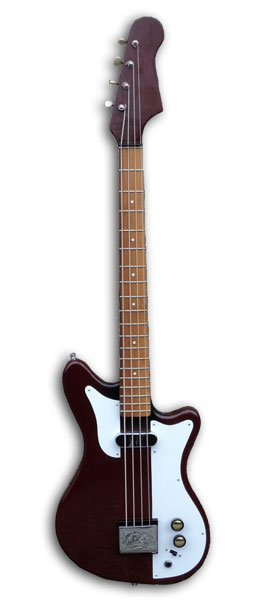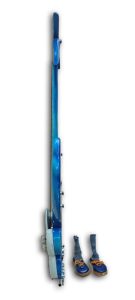Historic British Guitars
Burns Vibra-Artist (1960)
Serial Number: None
Introduced in December 1959, the Short Scale De-Luxe Artistes model was the first electric to emerge from the newly formed Ormston-Burns company. This six-string solid soon received some significant refinements, while the unwieldy title was abbreviated to the much more manageable Artist (or Artiste, as Burns used either spelling). By May 1960 the guitar was sporting an integral vibrato tailpiece and the model name was altered to Vibra-Artist to match.
In this revised form, Jim Burns’ first creation for his own company was undoubtedly an advanced electric at that time and accordingly far ahead of any UK competition, incorporating innovative features such as a 24-fret fingerboard; contoured, heel-less neck/body joint; a comprehensive control system and built-in vibrato unit. The Vibra-Artist continued in production for a further two years and during that time it underwent amendments to certain aspects, although many of these alterations were mainly cosmetic and the basic design remained essentially the same.
The absence of any serial numbering system on these early Burns makes it difficult to establish their age, and this can only be achieved by noting relevant date-related changes to construction and components. The features of this example indicate that it was made during 1960, as the fingerboard is sycamore rather than the later rosewood, and an ultra-slim neck adopts the distinctly asymmetric profile favoured by Jim Burns for the early Artists. In addition, the three Tri-Sonic single-coils are the smaller type with chromed covers that lack any logos. The slim depth body means these have to be top-mounted on the black plastic scratchplate, which also carries all controls. These ostensibly comprise volume and tone pots per pickup, plus a three-way lever-type selector and rhythm/solo slide-switch, but on many Vibra-Artists the circuitry can offer series, parallel and out-of-phase aural options.
The accompanying output jack is the original mini type, which is unusual, as over the years most owners tended to replace this component with the standard 1/4″ size socket. Another modification quite common to many Vibra-Artists concerns the bridge, because the original Burns’ design suffered from various rattles and buzzes, so players often cured these problems by replacing the whole assembly, usually with something simpler. Such alternatives included the stand-alone, Bigsby-made, single-saddle bridge, while this example employs a modern, more basic equivalent.
The glued-in neck and one-piece, contoured body are mahogany, with the latter’s quite compact dimensions being determined by the maximum measurements of the available raw material. Standard finish for the Vibra-Artist was a cherry red body and headstock, with a black ‘blown-in’ neck, but although this guitar has been repainted at some time, the colour match comes quite close to the real thing. Despite the short (23 3/8″) scale length, the fingerboard accommodates a double octave’s worth of frets, i.e. 24, and the novel, smoothly shaped heel-less neck/body join allows easy access to all.
The Vibra-Artist’s attributes were reflected in an asking price of £78, which was about a third more than that of the earlier Artist. This made it an expensive electric for the time and, like virtually all Burns, it was aimed primarily at the professional performer, rather than less experienced players. Even so, it soon began appearing in the hands of many embryonic axe heroes and certainly helped to establish Burns as the UK’s most prominent guitar maker. The Vibra-Artist’s styling, components and cosmetics created a distinctive combination that have made this model an iconic electric of the early ’60s era, displayed to good effect by this sympathetically restored example.
Paul Day (April 2012)
Broadway 1925 Bass Guitar (c1962)
Serial Number: None
Broadway was a brandname belonging to UK importers/wholesalers Rose-Morris and appeared on a wide range of musical instruments and related equipment. This comprehensive catalogue naturally encompassed electric guitars, which were added when demand increased dramatically at the start of the ’60s. The majority of Broadway-branded solid bodies were imported from Japan, but Rose-Morris augmented the range with some British-built examples and these home-grown alternatives included a couple of bass guitars, introduced around 1961/62. The cheaper of the two carried the Rose-Morris catalogue designation 1925 and it was actually the UK-made equivalent of an earlier, Far Eastern-origin four-string that had been sold under the Star brand banner as the 1869 model. Similarly styled, but slightly different from its predecessor, the British-built 1925 still targeted the beginner bassist, while the appropriately simple format also stayed the same.
The slab mahogany body is scaled down in size and its offset shape hints at the Fender Jazzmaster. The headstock is equally Fender-ish and carries Van Gent-made guitar-type tuners, which were a common component choice at that time. The glued-in neck is also mahogany and carries a rosewood fingerboard, although earlier examples employed maple and this material change mirrored other UK-made electrics of the era. Frets number 19 and are spread over a short (27.5″) scale length that was also a popular preference back then.
The body and headstock are finished in dark cherry red cellulose, while the neck is black, and this contrasting combination was also seen on electrics from makers such as Burns and Fenton-Weill. In fact, while not conclusive, all available evidence indicates that this compact four-string was indeed built by the latter company, as various aspects of construction, components and cosmetics provide appropriately strong links to this UK maker.
Like the distinctive metal strap buttons, the chrome-covered single-coil is certainly from Fenton-Weill, sitting in a shallow recess near the neck end and screwed straight to the body front. The partner controls comprise volume and tone pots, plus a somewhat optimistic rhythm/solo slide-switch. Along with the output jack, these are carried on a thin, white plastic scratchplate that runs the length of the body’s right side. A small, separate section up on the left horn provides a distinctive visual touch, echoing the appearance of the Japanese-origin original.
Strings anchor in a combination bridge/tailpiece that’s the same as the type used on some equally inexpensive Vox basses of the period. Mounted on a chunky black plastic plinth that provides necessary height clearance, the rather basic, bent steel baseplate features two adjustable bridge saddles and is topped by a clip-on, chromed metal cover.
Although Rose-Morris literature suggests otherwise, the 1925 bass guitar actually carried no brand logo or any other ID indicator. Despite a shortlived production span lasting only around two years, it proved quite popular with beginner beat groups in the early ’60s, as the £35 selling price made this quite stylish, four-string solid more affordable than some of the contemporary competition.
This particular instrument had been subjected to a few owner-perpetrated, misguided modifications, but these have now been rectified as part of a thorough restoration and the end result now represents an ideal example of one of the lesser-known, but equally important, entry-level British basses.
Paul Day (April 2012)
Eastwood ‘Blue Moon’ (1980)
Back in 1980, any new single by UK act Showaddywaddy was virtually guaranteed chart placing, helped in no small way by the band’s accompanying high-profile exposure on national television.
Showaddywaddy approached British guitar maker Brian Eastwood, requesting a six-string that would visually represent and help promote their latest release – a revival of the oldie ‘Blue Moon’. Such a commission was naturally welcome, but it came with a completion deadline of three weeks, which was reduced to a mere seven days when the record charted earlier than expected!
Based on an idea by artist friend, Jim Cooper, Eastwood worked flat-out for a sleepless 72 hours to turn the original cartoon concept into 3-D reality. Successfully achieving the seemingly impossible task of creating and completing such a complex custom one-off within the allotted week, he delivered it, with paint still drying, just in time for the group’s appearance on BBC TV’s “Top Of The Pops” on 27th November 1980. Eastwood’s under-pressure efforts certainly weren’t in vain, as his guitar made an impressive debut and was subsequently featured on other TV shows and live performances by the band.
This suitably sad six-string employs the headless guitar principle, with both the bridge and tuners obscured by a white cloud. The latter carries lightning bolts that emanate from the volume and tone controls governing a purpose-built, powerful pickup hidden within the body. Short denim-clad legs terminate in blue (suede?) shoes and are intended to enhance the visual effect, but these are easily detached if desired.
Exuding animation and comic-sad character, the Eastwood ‘Blue Moon’ is a true testament to the custom-maker’s craft. Although a fully functioning electric guitar, its somewhat limited practical playing abilities are far outweighed by ultra-photogenic appearances. This unique instrument has been employed to eye-catching effect in numerous prominent guitar books and magazines published during the past 25 years. More recently the “Blue Moon” was featured in 2008 on BBC TV’s “History of the Guitar” and Showaddywaddy were reunited with the instrument on stage at the Princess Pavilion, Falmouth, U.K. on 8th May 2010.
Paul Day (June 2012)
Paul Day – Guitar Expert
Paul Day is a world recognized expert on electric guitars.
He wrote “The Burns Book” which is the definitive work on Jim Burns and his guitars and has co-written books including, The Fender Book, The Gibson Les Paul Book, The Gretsch Book, The Guru’s Guitar Guide, the Rickenbacker Book and The Ultimate Guitar Book. He has contributed to nearly 200 other books including from countries as diverse as Sweden, U.S.A., Japan, Germany, Holland.
In a writing career which spans over 40 years he has contributed as a writer or given assistance to over 30 magazines or publications including “Guitarist”, “Guitar & Bass Magazine”, “Gitarre & Bass” (Germany), “Guitar” (Japan) -some under different names including his own (!) and as the “Guitar Guru”.
Paul has also acted as a consultant or given assistance to over 30 manufacturers of electric guitars, amplifiers and accessories including Kent Armstrong (pick-ups), Ernie Ball Music Man (guitars), Burns (guitars, amplifiers and effects), Hi- Watt (amplifiers), Hohner (guitars), Picato (strings), Sever (guitars) (Slovenia), Shergold (guitars), Status (basses & guitars), Tanglewood, Tokai (guitars) (Japan), Trevor Wilkinson (guitars).
Additionally, Paul has provided assistance, consultation etc. to many well known artists including, Billy Bragg, Gordon Giltrap, George Harrison, Steve Howe, Jeff Lynne, Chris Stein and in a playing career spanning almost 50 years he has performed with several bands including “The Downtowns”, “Great Expectations”, “Shine” and “Status Clone”.
Paul has also provided expert advice to various distributors including “Aria” (U.K.), Barnes and Mullins, M.Hohner, John Hornby Skewes, Washburn and retailers such as Cranes, Music Ground, Warwick Guitars. Also his expert knowledge has been utilized by international salerooms and auction houses including Bonhams, Christies, Gardiner Houlgate, Sothebys- not forgetting, of course, HM Customs & Excise!
Finally, Paul has been featured in the local and national press, radio and on TV many times during his career including on BBC TV’s “Pebble Mill at One”, “The Tube” and, most recently, on BBC TV’s acclaimed 3 part series “The Story of the Electric Guitar” in 2008. He also has a personal collection of around 250 guitars and a library of musical memorabilia and miscellania which includes details of over 2,500 different brands of electric guitars!
Paul Day really is, as one of his pen names suggest, “The Guitar Guru” and I have been very fortunate to have been a beneficiary of his invaluable help, restoration skills and expert advice for many years.
Guy Mackenzie. The Guitar Collection. June 2012.




